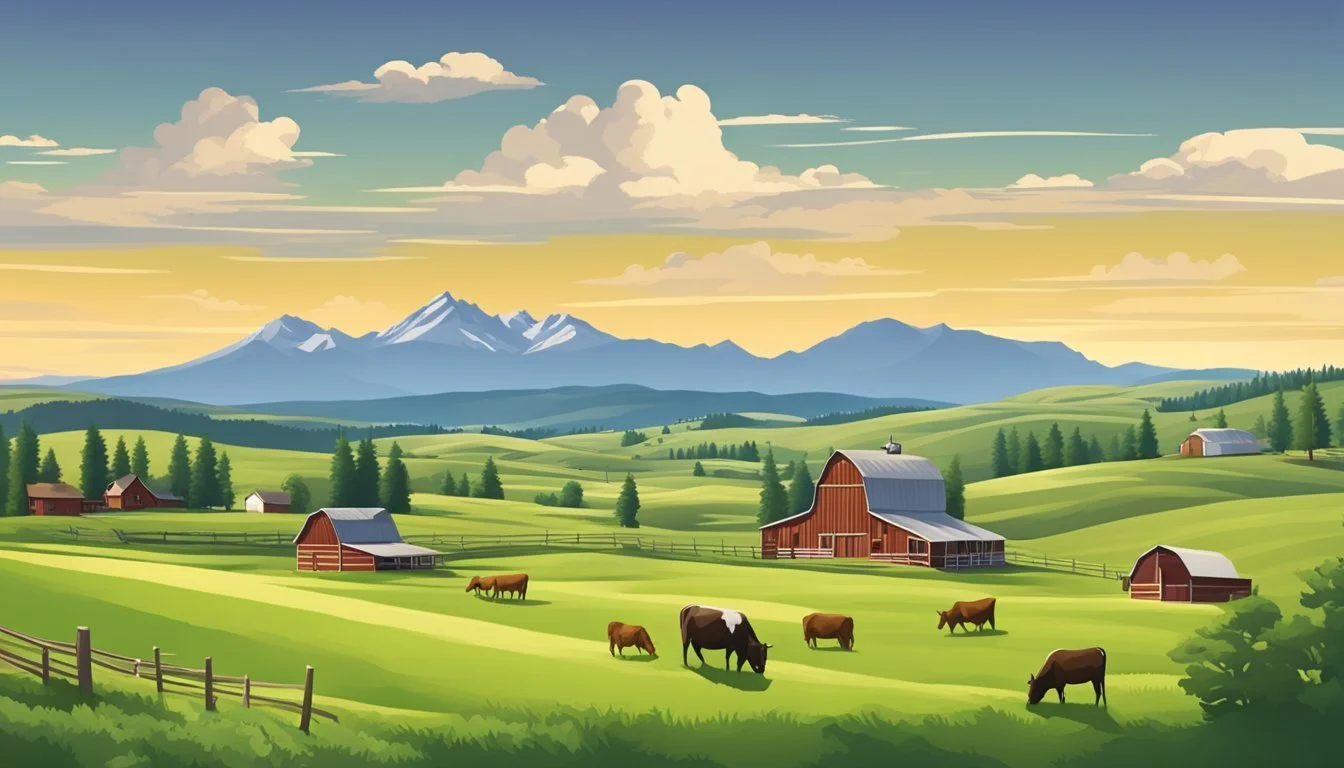Small Farms for Sale in Montana
Your Guide to Rural Opportunities
This Article is Part of State-by-State Guide to Buying Your First Small Farm
Montana's expansive landscape offers a unique opportunity for those seeking a pastoral lifestyle or a venture into the agricultural business. Small farms dot the region, presenting an array of properties that cater to various farming aspirations and budgets. These farms span diverse ecosystems from the mountain-bordered ranches of the West to the rolling plains in the East, making Montana a fitting place for both traditional ranching and niche agricultural operations.
The market for small farms in Montana showcases a range of properties that suit hobby farmers and serious agricultural entrepreneurs alike. Available listings demonstrate that these farms often come with the necessary amenities for immediate operation, including irrigation systems, outbuildings, and established pastures. Potential buyers can find properties under 50 acres suitable for small-scale operations or larger tracts that provide room for expansion. With such variety, the small farm market in Montana continues to attract attention from across the nation.
Understanding Montana's Farm Real Estate Market
When looking into purchasing small farms in Montana, prospective buyers will find that land values and purchase prices are influenced by a range of factors that can vary significantly across the state.
Factors Influencing Property Values
Several elements affect the value of farm real estate in Montana. The size of the property, its location, and access to resources such as water, play pivotal roles. For example, small farms that are closer to bigger cities like Bozeman or Missoula tend to have higher values due to the demand for proximity to urban amenities. Conversely, more remote properties in less populated counties might be less expensive but still offer ample space and a serene environment.
Land quality is also a significant factor. Fertile soil, favorable topography, and the potential for expansion or development can either raise or lower the value. For instance, a 15.4-acre farm in Silver Bow County might have a different value compared to a similar-sized land in Gallatin County based on soil fertility and development opportunities.
Demystifying Purchase Prices
Understanding purchase prices requires looking at the real estate market trends and historical sales data in Montana. The sale prices for small farms can range considerably:
Under $100,000: Smaller parcels or properties that may require significant investment for improvements.
$100,000 - $500,000: A broader range with variables like land size and amenities contributing to the price.
$500,000 - $1,000,000: Larger farms or those with established operations and housing might fall into this category.
For example, a 20-acre farm with a residence in Western Montana might be priced around $799,000, reflecting its developed infrastructure and land quality. Meanwhile, a 39-acre property in Park County could list for $3,250,000, indicating its premium location or potential for recreational use or significant agricultural production. Buyers must examine individual listings to understand the specifics that justify each farm's price tag.
Types of Small Farms in Montana
Montana offers a diverse array of small farming options tailored to various lifestyles and farming aspirations. The state caters to those seeking the idyllic simplicity of country living, whether it's via hobby farming ventures, the practical embrace of rural mini farms, or the picturesque charm of country farmettes.
Distinguishing Hobby Farms
Hobby farms in Montana typically seamlessly blend rural living with the joys of small-scale agriculture. They are often characterized by their modest acreage, with land parcels usually ranging from 10 to 50 acres. Owners might cultivate a variety of crops or maintain small herds of livestock, fueled by a passion for farming rather than the drive for large-scale commercial profit.
The Allure of Rural Mini Farms
Rural mini farms, spread across regions like Musselshell County and Park County, represent a strategic investment for those seeking a self-sufficient lifestyle. These farms commonly span 5 to 10 acres and are perfect for sustainable crop production, small orchards, or boutique livestock breeding. Buyers are drawn to their manageable size and the potential for personalizing their agricultural practice.
The Charm of Country Farmettes
Country farmettes in Montana often feature cozy home structures accompanied by manageable parcels of land, usually under 5 acres. They are the quintessential symbol of country living with enough space for personal gardens, a few animals, and the tranquility of the surrounding natural landscape. These small farms often appeal to individuals or families looking for a taste of rural life without the commitment to large-scale farming.
Analyzing Farm Size and Features
When considering small farms for sale in Montana, prospective buyers should prioritize understanding the relevance of property size and the specific acreage needed for various types of livestock.
Assessing Property Size Relevance
Property size determines both the potential usage and capacity of a farmland. In Montana, small farm plots can range from under 10 acres to nearly 40 acres. For instance, listings in Silver Bow County advertise smaller plots around 15 acres, while those in Park County may offer closer to 40 acres. Each buyer must evaluate the size against intended uses, whether for cultivation or raising animals.
Acreage Requirements for Livestock
Livestock requirements vary by species; these guidelines ensure humane treatment and operational efficiency:
Goats: Typically, 2-10 goats per acre, depending on pasture quality.
Sheep: Similar to goats, they require around an acre per 5-10 animals.
Poultry: Minimal acreage is needed, but outdoor access improves well-being and productivity.
For each type of livestock, considerations extend beyond just acreage. Infrastructure like fencing, shelter, and access to water significantly impacts the land's suitability for animal husbandry.
The Buying Process
When purchasing a small farm in Montana, buyers should be thorough in understanding real estate listings, be aware of the nuances that first-time farm buyers might encounter, and recognize the legal intricacies involved in land transactions.
Navigating Real Estate Listings
Real estate listings provide a snapshot of the small farms available for sale in Montana, offering vital details such as the purchase price and acreage. Buyers should analyze these listings intensely to compare properties and discern their true market value. Here's a quick guide to understanding listings:
Price per Acre: Review the cost per acre to judge the competitiveness of the purchase price.
Property Features: Look for specifics like water rights, mineral rights, and existing farm infrastructure.
Location: County and proximity to amenities can dramatically impact a farm's long-term value.
Tips for First-time Farm Buyers
First-time farm buyers should embark on this journey with certain considerations in mind to avoid common pitfalls. They can benefit from the following advices:
Budget: They should calculate their budget, considering not only the purchase price but also ongoing operational costs.
Prioritize Needs: They should list out their essentials, such as size and soil quality, versus desirable features.
Professional Help: Securing a realtor experienced in farm properties can provide them with insights on listings and help navigate the buying process.
Legal Considerations in Land Transactions
Legal aspects of purchasing farmland must be handled with precision. Buyers should be aware of:
Zoning Laws: They need to check local zoning regulations to ensure their intended use is permitted.
Property Surveys: They should commission a current survey to confirm property boundaries.
Title Search: They must conduct a thorough title search to uncover any liens or encumbrances.
By focusing on the above entities and adhering to these guidelines, buyers can approach the purchase of a small farm in Montana with confidence and clarity.
Farm Management Best Practices
Effective farm management practices are essential for the success and sustainability of small farms in Montana. A focus on maximizing productivity while preserving the land and resources sets the foundation for a thriving agricultural operation.
Sustainable Agriculture Techniques
Cover Cropping: Farmers can implement cover cropping to enhance soil fertility and structure, manage water efficiently, and suppress weeds. Crops like clover or rye can be planted during the off-season, and later, they are tilled back into the soil to act as green manure, benefiting subsequent plantings.
Rotational Grazing: Small farms raising livestock such as goats and sheep can practice rotational grazing. By moving livestock between multiple pastures, farmers allow vegetation in previously grazed areas to recover. This approach reduces soil erosion, improves pasture health, and maintains the welfare of the animals.
Integrating Livestock and Crop Production
Polyculture: Diversifying crop production by growing multiple crop species on one farm can reduce pests and diseases and promote a balanced ecosystem. This method is particularly beneficial for small farms, which often don't have the luxury of extensive land for monoculture farming.
Synergistic Relationships:
Goats: They can be integrated into a farm's weed management system because of their appetite for invasive species.
Sheep: Their grazing contributes to the control of crop pests and improves soil fertility through natural fertilizers.
Poultry: Chickens and other fowl can contribute through pest control, fertilization, and by providing eggs as an additional revenue stream.
Implementing these practices allows small farms to capitalize on their diverse agricultural ecosystems, producing multiple products and maintaining soil health.
Financial Considerations
When looking to purchase small farms in Montana, buyers should have a clear understanding of not only the purchase price but also the startup and ongoing operational costs. They should also be aware of the tax implications associated with owning and operating a farm.
Estimating Startup and Operational Costs
Buyers need to closely examine the initial investment required beyond the purchase price of the property. Startup expenses can include but are not limited to:
Land preparation: Costs for clearing, plowing, and soil treatment.
Buildings and facilities: Expenses for constructing or renovating barns, sheds, and other farm buildings.
Equipment: Prices for tractors, tools, and other machinery needed for farm operation.
Livestock: If applicable, costs for purchasing animals.
Operational costs are recurrent and include:
Feed and livestock care: Regular expenses for those owning animals.
Seeds and planting materials: Costs incurred every planting season.
Utilities: Charges for water, electricity, and gas.
Maintenance: Regular upkeep of equipment and facilities.
Understanding Tax Implications
Owning a farm can significantly affect a buyer's tax situation. They should consider:
Property Taxes: These may vary greatly depending on the size and location of the farm.
Income Taxes: Potential deductions related to farm income and expenses, which can lower taxable income.
Estate Taxes: Implications for heirs upon the owner's death.
Prospective owners are advised to consult with a tax professional familiar with real estate and agricultural tax law in Montana to ensure comprehensive understanding and compliance.
Conclusion
Montana presents a valuable opportunity for individuals seeking to invest in small farms. With a range of properties spanning across various counties, buyers can choose from diverse land options. For instance, Silver Bow County and Musselshell County offer farms under 20 acres, potentially perfect for those starting on a smaller scale or preferring a more manageable property size.
The investment in Montana small farms can be seen as a long-term venture, where the average price of farms typically reflects the vast open spaces and beauty of the untapped wilderness. Taking into account the livestock options available, such as cattle, horses, goats, sheep, and pigs, the state's agricultural landscape supports a variety of farming activities.
Given the range in price points—from under $100,000 to several million dollars—prospective buyers have flexibility in their investments. Farms in areas like Livingston and Roundup have appeared on listings recently, indicating there is movement and availability within this market.
When considering purchasing a small farm in Montana, one may examine the following factors:
Location: Vital for logistical purposes and lifestyle preferences.
Land Size: To suit the scale of agricultural activities planned.
Price: To align with budget and financial goals.
Type of Livestock: To match the farm's purpose and potential revenue streams.
Interested parties are encouraged to conduct thorough research or consult with local real estate experts to navigate the small farm offerings in Montana effectively.







